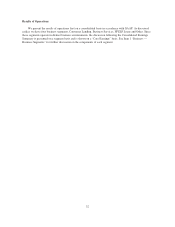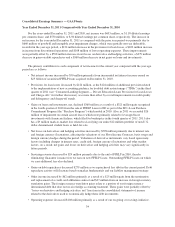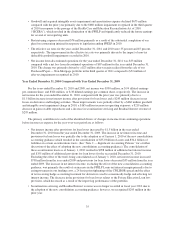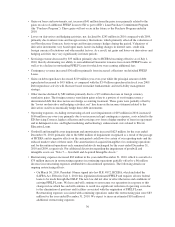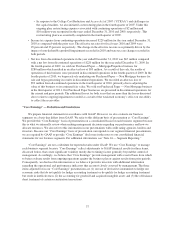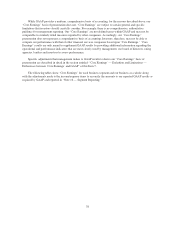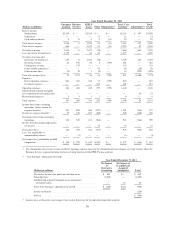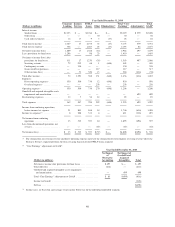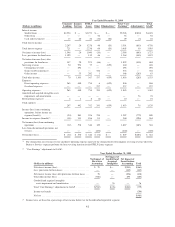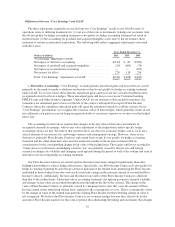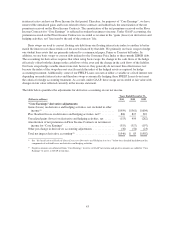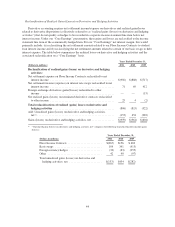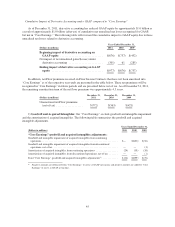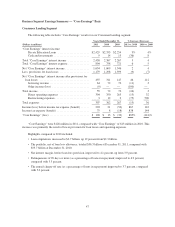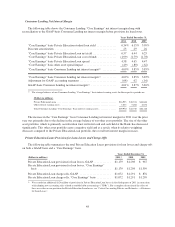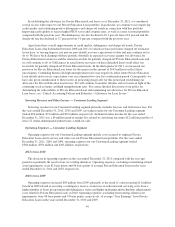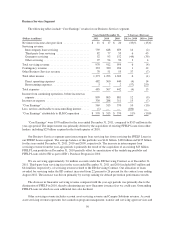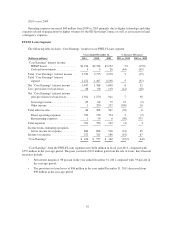Sallie Mae 2011 Annual Report Download - page 44
Download and view the complete annual report
Please find page 44 of the 2011 Sallie Mae annual report below. You can navigate through the pages in the report by either clicking on the pages listed below, or by using the keyword search tool below to find specific information within the annual report.
Differences between “Core Earnings” and GAAP
The three adjustments required to reconcile from our “Core Earnings” results to our GAAP results of
operations relate to differing treatments for: (1) our use of derivatives instruments to hedge our economic risks
that do not qualify for hedge accounting treatment or do qualify for hedge accounting treatment but result in
ineffectiveness (2) the accounting for goodwill and acquired intangible assets and (3) the off-balance sheet
treatment of certain securitization transactions. The following table reflects aggregate adjustments associated
with these areas.
Years Ended December 31,
(Dollars in millions) 2011 2010 2009
“Core Earnings” adjustments to GAAP:
Net impact of derivative accounting ....................... $(540) $ 83 $(502)
Net impact of goodwill and acquired intangibles ............. (24) (699) (76)
Net impact of securitization accounting .................... — — (201)
Net income tax effect .................................. 220 118 296
Total “Core Earnings” adjustments to GAAP ................ $(344) $(498) $(483)
1) Derivative Accounting: “Core Earnings” exclude periodic unrealized gains and losses that are caused
primarily by the mark-to-market valuations on derivatives that do not qualify for hedge accounting treatment
under GAAP. To a lesser extent, these periodic unrealized gains and losses are also a result of ineffectiveness
recognized related to effective hedges. These unrealized gains and losses occur in our Consumer Lending,
FFELP Loans and Other business segments. Under GAAP, for our derivatives that are held to maturity, the
cumulative net unrealized gain or loss over the life of the contract will equal $0 except for Floor Income
Contracts where the cumulative unrealized gain will equal the amount for which we sold the contract. In our
“Core Earnings” presentation, we recognize the economic effect of these hedges, which generally results in any
net settlement cash paid or received being recognized ratably as an interest expense or revenue over the hedged
item’s life.
The accounting for derivatives requires that changes in the fair value of derivative instruments be
recognized currently in earnings, with no fair value adjustment of the hedged item, unless specific hedge
accounting criteria are met. We believe that our derivatives are effective economic hedges, and as such, are a
critical element of our interest rate and foreign currency risk management strategy. However, some of our
derivatives, primarily Floor Income Contracts and certain basis swaps, do not qualify for hedge accounting
treatment and the stand-alone derivative must be marked-to-market in the income statement with no
consideration for the corresponding change in fair value of the hedged item. These gains and losses recorded in
“Gains (losses) on derivative and hedging activities, net” are primarily caused by interest rate and foreign
currency exchange rate volatility and changing credit spreads during the period as well as the volume and term of
derivatives not receiving hedge accounting treatment.
Our Floor Income Contracts are written options that must meet more stringent requirements than other
hedging relationships to achieve hedge effectiveness. Specifically, our Floor Income Contracts do not qualify for
hedge accounting treatment because the pay down of principal of the student loans underlying the Floor Income
embedded in those student loans does not exactly match the change in the notional amount of our written Floor
Income Contracts. Additionally, the term and the interest rate index of the Floor Income Contract is different
than that of the student loans. Under derivatives accounting treatment, the upfront payment is deemed a liability
and changes in fair value are recorded through income throughout the life of the contract. The change in the
value of Floor Income Contracts is primarily caused by changing interest rates that cause the amount of Floor
Income earned on the underlying student loans and paid to the counterparties to vary. This is economically offset
by the change in value of the student loan portfolio earning Floor Income but that offsetting change in value is
not recognized. We believe the Floor Income Contracts are economic hedges because they effectively fix the
amount of Floor Income earned over the contract period, thus eliminating the timing and uncertainty that changes
42


